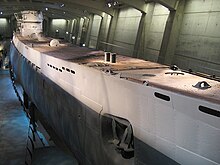Double hull boat
A two-hulled boat is a submarine that has been designed and produced according to a special ship construction method. Double hull boats were mainly used in the First and Second World Wars . After the end of the Second World War, they were gradually replaced by single-hull boats with a hydrodynamically optimized hull shape . Most Russian nuclear submarines are an exception.
Until about the middle of the 19th century, the first underwater vehicles were built as single-hulled boats, this was mainly due to the lack of technical possibilities. It was not until the middle / end of the 19th century that the developers succeeded in attaching the propellers and the subsurface rudder of the submarines to the hull in such a way that the vehicles could be moved and controlled independently without being pulled on the surface by an escort vehicle. These technical innovations brought some advantages for submarine construction. The construction of the hulls was reinforced by metal inserts, until the first submarines were finally built from a complete steel hull at the beginning of the 20th century, as the boats of the Forelle class show , for example . The advantages of these boats quickly became clear, as they were particularly visible in the form of improved seaworthiness when sailing above water and also offered a significantly increased stability of the hull and the pressure hull hull . Since the first submarines of the 20th century mainly drove over water and only went on diving trips for attack purposes or to escape , different demands had to be made on these boats in terms of their design and construction. In order to make the submarines "seaworthy", they were technically modified in terms of construction, the so-called " two-hulled boats " were created.
Two-hulled boats are characterized by the fact that around the cylindrical, shaped submarine pressure hull made of metal, the 1st hull, the diving cells were placed as the 2nd hull. This had the particular advantage that it gained more space in the actual pressure hull for the crew, controls and armament because the immersion tanks could be outsourced. In addition, it was now possible to have an outer shape that was more suitable for surface travel. Since the so-called 2nd shell was under the same pressure inside and outside when diving, it no longer needed to be particularly strong, which meant that the weight of the submarine no longer increased significantly. The weight changes caused by fuel consumption were compensated for by the semi-open fuel oil bunker also located outside the pressure hull, into which seawater could flow.
With the increasing technical development towards the end of the Second World War, the surface aspect of the submarine gradually disappeared and thus again made fewer demands on the stability of a corresponding hull. The two-hulled boat was initially given a hydrodynamically clean, smooth shape, American developments around the test submarine USS Albacore finally led to the teardrop shape that is predominantly built today.
Russian submarines
Many Russian nuclear submarines such as the Akula-class , Sierra-class and the Oscar-class are two-hulled boats, whereby the distance between the first hull and the actual pressure hull can be several meters depending on the class. The reason for this design feature is the better protection against explosions (i.e. torpedoes , depth charges), so that most ships cannot be sunk with a warhead weighing less than 50 kg.
